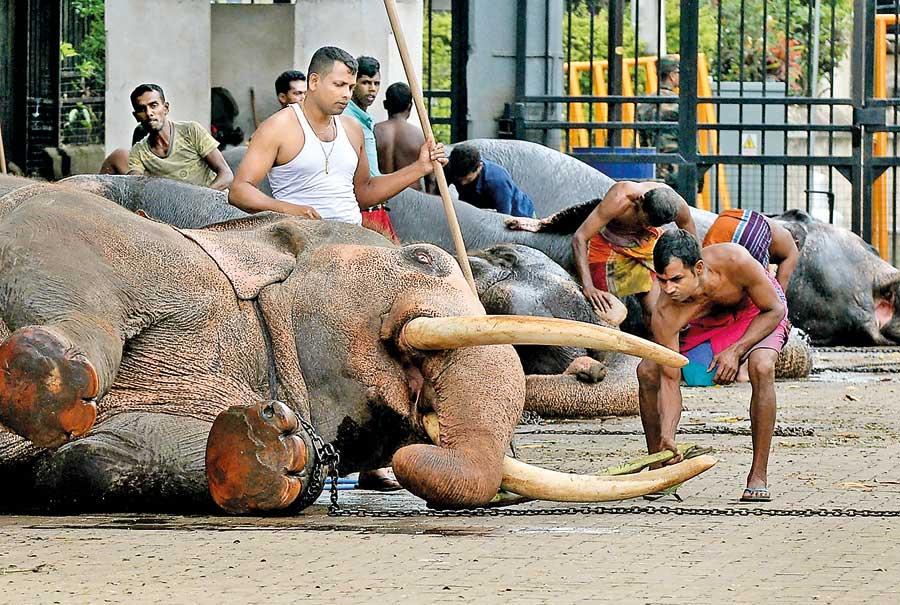06 Sep 2023 - {{hitsCtrl.values.hits}}

If the gifting of elephants to places of authority like temples are completely stopped with time there will be less ‘jumbos’ in captivity
The recent incident featuring elephants running amok at the Kandy perahera went viral on Social Media. One elephant, who perhaps couldn’t bear the stress, had apparently run amok. In the process it had upset several more elephants as well. This incident, and the publicity it is getting, and the outcry from animal rights activists, is certainly going to throw the spotlight locally and internationally on the treatment of these animals at such pageants and in captivity. My view is that all the bad publicity we are getting due to this incident can be used to leverage some action from the authorities to address the plight of captive elephants in Sri Lanka.
the process it had upset several more elephants as well. This incident, and the publicity it is getting, and the outcry from animal rights activists, is certainly going to throw the spotlight locally and internationally on the treatment of these animals at such pageants and in captivity. My view is that all the bad publicity we are getting due to this incident can be used to leverage some action from the authorities to address the plight of captive elephants in Sri Lanka.
From time in memorial elephants have been used for war, pageants and as labour. However the methods used to tame, and subsequently care and manage elephants is brutal and inhumane at times; such acts attracting severe criticism in the recent past.
This problem has become very serious in Sri Lanka as pointed out by many animal rights activists. They point out that when taming an elephant it is ill-treated. Most often fingers are pointed at many Buddhist temples which have in their possession elephants; and mahouts are employed to control them.
There is no doubt that elephants should never be held captive. Period. They are highly social animals who need close interaction with family units and freedom to move around.
Even if held in captivity, there are norms accepted the world over for keeping animals in captivity. It is based on the rights of the animal’s freedom.
Five freedoms for animal welfare
1. Freedom from hunger and thirst
2. Freedom from discomfort
3. Freedom from pain, injury and disease
4. Freedom to express normal behaviour
5. Freedom from fear and distress
(Source-Britain’s Farm Animal Welfare Council in 1965)
It is very evident from numerous documented evidences that none of these principles are adhered to with Sri Lankan elephants in captivity.
There is much hue and cry made by some animal rights activists that all captive elephants should be freed. This is indeed are very foolish remarks to make. These captive elephants have got used to being looked after by people hence they can never be rehabilitated fully, to return to the wild. This is why the orphaned elephants at the Elephant Transit Home in Uda Walawe are allowed to roam free with other elephants so that they can develop bonds with each other. They have minimal interaction with the curators, so that eventually they can be released into the wild.
So the sooner we accept that these 130 odd elephants in captivity cannot be released into the wild, it will be better to try and think through in obtaining a logical solution.
There is much hue and cry made by some animal rights activists that all captive elephants should be freed. This is indeed are very foolish remarks to make. These captive elephants have got used to being looked after by people hence they can never be rehabilitated fully, to return to the wild
Management of captive elephants
To mitigate the current situation I would propose the following steps
Why pageants ?
The Kandy Perahera (Pageant) is believed to have started in the 3rd /4th century B.C. The use of elephants in the pageant may have cultural significance, but it has no religious significance as some may like to believe. No Buddhist Suthras (teachings) talk about the need for elephants to be paraded like this. Gautama Buddha has decreed loving kindness and compassion (meththa and Karuna) towards all living beings; not torturing and parading shackled elephants.
In an recent article in Ground Views Ms Sunela Jayewardene writes
“The inclusion of elephants in a perahera seems to have been inevitable. Its size and strength made it an obvious choice to fashion a tradition of bearing sacred or precious objects. This undeniably majestic animal, which has long been considered a culturally auspicious symbol, was sometimes even a symbolic representation of the monarch…. It is unclear how the exposition of the sacred relic, borne on the back of an elephant, was incorporated in a rainmaking festival. But when a ritual is as old as the perahera of Sri Lanka, there are bound to be revisions and reversals. At the perahera in the smaller temples, the common practice was to carry a portrait of the king and the royal elephant, as it was well understood that captive elephants were as precious as the monarch to whom they belonged.”
There is no doubt that prolonged walking at snail pace, amidst a cacophony of drums and fire, will stress the elephants greatly. Although they seem to be walking placidly, they are stressed. And since elephants have different personalities, the stress will affect individuals differently.
In fact it was only on the day before this incident, on the first night of the Kumbal Perahera, that I posted a video clip on Facebook of a highly stressed animal, swaying his head and trunk vigorously from side to side ( typical stress related displacement behaviour) being forced to walk in the procession. The idiot of a commentator over the TV was saying that the elephant was swaying to the rhythm of the drums!
What I think happens is that the owners somehow want the animal paraded in the pageant. They earn money and prestige. So even if the animal shows signs of agitating they somehow get the mahout to subdue it (most often by foul means) and force it to continue in the procession. Usually animals will conform through fright, but sometimes (like in this incident) the stress will be too much and it will run amok.
And the sad part was to see newspapers reporting of an ‘elephant rampage at the perahera’. Nothing could be far from the truth. These elephants were running out of fear from the stressful environment they were in. Not one person was badly hurt in spite of several four ton animals running all over the crowded streets. There is footage of one poor elephant even trying to climb into the Queens Hotel veranda.
While parading these poor animals in pageants is not acceptable, in the context of the ‘religious’ connotations, completely suspending the use of elephants in pageants may not be practically possible immediately. It will have to be controlled and managed. I know many of my animal right activist friends will not agree with me, but I am only trying to be practical and cognisant of the ground realities. Hence a realistic, practical approach is needed. The next best compromise is to ensure that there is a strict code of conduct, strictly enforced by an external agency, for the use of elephants in pageants.
There should be high powered task force set up comprising representatives of
If the gifting of elephants from Pinnawela or the zoo is completely stopped as suggested earlier, with time there will be less elephants in captivity, as the existing older elephants die off. Then in a decade or two there will be no more captive elephants in Sri Lanka, thus resolving the issue on its own.
Conclusion
I am aware that the aforesaid is somewhat utopian. In a Sri Lankan context we all know what happens with committees and task forces. They often end up as toothless damp squibs.
The animal rights activists must get-together and speak in one voice, and leverage this incident to bring pressure on the government. The two task forces must be set up under presidential decree with proper legislation and authority and if they work in tandem there could be a chance. It would be vital to have the private sector also involved which will then ensure proper operation and follow up and to mitigate external pressures and ‘hidden agendas’ .
And then perhaps these magnificent gentle giants will be free to roam the jungles of Sri Lanka!
09 Jan 2025 2 hours ago
09 Jan 2025 4 hours ago
09 Jan 2025 6 hours ago
09 Jan 2025 6 hours ago
09 Jan 2025 7 hours ago